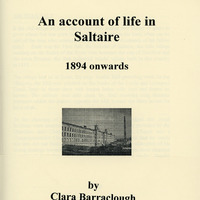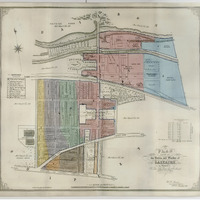C3a-075a: An account of life in Saltaire: 1894 onwards
Item
- Identifier
- C3a-075a
- Title
- An account of life in Saltaire: 1894 onwards
- Type
- Format
- Date Created
- 20th century, late
- Creator
- Barraclough, Clara
- Description
- An account of life in Saltaire 1894 onwards by Clara Barraclough [nee Knott]. Associated with a photograph of the Yorkshire Amateur Swimming Association in 1961 [C3a-075c], Shipley Swimming Team [C3a-075] and a note about Martha Knott.
- Subject
- Associated place or event
- Source
- Gift: Barraclough, Clara
- Rights
- Only viewable in the Saltaire Collection
- Rights Holder
- Copyright Clara Barraclough
- Access Rights
- To view the full story please contact the Saltaire Collection
- Abstract
-
Clara writes:
One day in June 1894, my family removed from West Bowling to Saltaire, six months previously my father (a textile worker) had obtained a post at Salt’s Mill, with the same wage, but being paid for all holidays and sickness, which was a great boon to a family of six. It made life much easier for him too, for during that six months it had been necessary for him to leave home before 5am every morning, in order to catch the 5.30 train from Bradford Forster Square stations and so arrive at the Mill for the 6am start. The day we removed, there was a dispute at the Mill, and all the workpeople were out in the streets and the Clerk of Works (Mr. Baker) was escorted from his home in Albert Road down to the mill by a policeman. Whatever the dispute it was soon settled, and things were back to normal next day.
We were allotted a house in Shirley Street (rent 4/- per week) which had a living room, kitchen, two bedrooms and a coal cellar, and of course our own flagged back yard and toilet. All the houses had coal fires in the living room and some had small fireplaces in the bedroom for use in sickness or severe weather. Cooking was done by a coal oven in the living room, the kitchen being used mainly for washing and washing up, etc. In addition to the coal oven, the living room range included a side pan (a type of water container which held about five or six gallons and was heated by fire). In the kitchen, water was heated by a set-pot, this consisted of a large galvanised or iron tub enclosed in a brick surround and heated by a fire underneath.
The white clothes were boiled in the set pot and were stirred around with a thybel (a large stick with a thick end). Coal was delivered loose, a tonne at a time was tipped on to the pavement and had to be shoveled down a chute into the cellar. There was a good choice of coals in those days, ‘nuts’ were small in size and burnt quickly, giving off a fierce heat, suitable for heating the oven, whilst ‘cobs’ were larger, burnt longer and were more suitable for heating the living room. Different qualities and prices were available from the different collieries, ‘Haigh Moor Best’ was our favourite brand together with Pope and Pearson’s ‘washed nuts’, none costing more than 1/- per cwt.” - Has Format
- image
- Item sets
Linked resources
| Title | Class |
|---|---|
 An account of life in Saltaire: 1894 onwards: Front cover An account of life in Saltaire: 1894 onwards: Front cover |
Image |
Export
Catalogue data (excluding media) available under Creative Commons Attribution-ShareAlike (CC BY-SA 4.0) licence.
